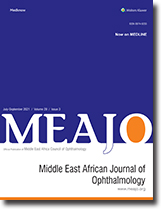Past History of Ocular Trauma in an Iranian Population-Based Study: Prevalence and its Associated Factors
Authors
Affiliations
1Noor Ophthalmology Research Center, Noor Eye Hospital, Tehran, Iran.
2Department of Epidemiology, School of Public Health, Shahroud University of Medical Sciences, Shahroud, Iran.
3Department of Community Medicine, School of Medicine, Tehran University of Medical Sciences, Tehran, Iran.
4Department of Epidemiology and Biostatistics, School of Public Health, Tehran University of Medical Sciences, Tehran, Iran.
Abstract
Purpose: The purpose of this study was to determine the prevalence of a history of ocular trauma and its association to age, sex, and biometric components.
Materials and methods: Residents of Shahroud, Iran aged 40-64 years, were sampled through a cross-sectional study using multistage cluster sampling. Three hundred clusters were randomly selected, and 20 individuals were systematically selected from each cluster. The subjects underwent optometric and ophthalmic examinations, and ocular imaging. A history of ocular trauma was determined through personal interviews.
Results: The prevalence of a history of trauma and blunt trauma, sharp trauma, and chemical burns were 8.57%, 3.91%, 3.82%, and 1.93%, respectively. After adjusting for age, the rate of all types of trauma was significantly higher for males. Only the prevalence of chemical burns significantly decreased with aging. A history of hospitalization was stated by 1.64% of the subjects. The axial length was significantly longer in cases with a history of trauma. The corneal curvature was significantly larger in cases with a history of sharp trauma and chemical burns. The prevalence of corneal opacities was significantly higher among cases with a history of the blunt trauma odds ratio (OR = 2.33) and sharp trauma (OR = 4.46). Based on corrected visual acuity, the odds of blindness was 3.32 times higher in those with a history of ocular trauma (P < 0.001). Conclusion: A considerable proportion of the 40-64-year-old population reported a history of ocular trauma. This observation has important health implications. Blindness, corneal opacities, and posterior subcapsular cataract were observed more frequently among these cases, and they demonstrated differences in some ocular biometric components.
Keywords: Cross-sectional Study; Middle-East; Ocular Trauma.

